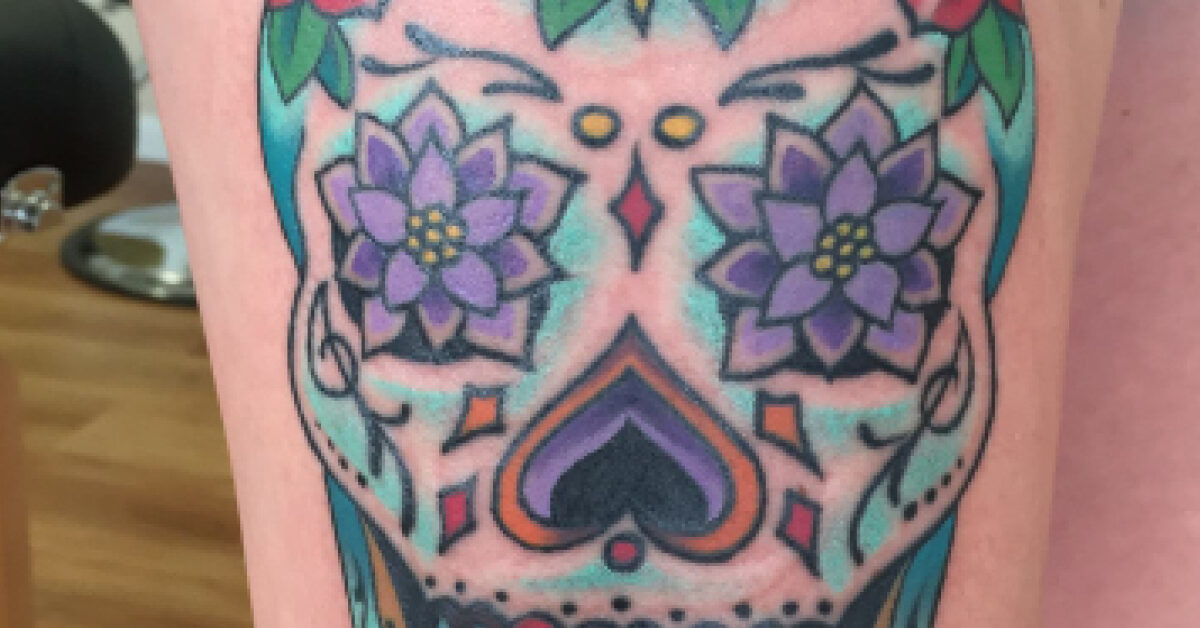
Alliance for Positive Growth’s Annual Banquet Celebrates Five Years of Progress in SWLA
December 2022
Chuck Eats Hits the Food Scene: January 20-29!
January 2023by Matt Dye
Tattoos have been around since 3200 B.C., but it seems recently that the art form has broken through previous taboos in America. It wasn’t even 20 years ago that friends would warn each other of the dangers of getting a visible tattoo and the effects it could have on future employment. Now it’s socially acceptable for more than just sailors to have entire arm sleeves, and with that change has come to the rise of tattoo artists and the evolution of the workplace.
Maura Cole, owner of Azalea Tattoos on E. College St., was born and raised in Lake Charles and has been in the tattoo industry for 22 years, but it wasn’t a path she initially set out on. Like most tattoo artists, she has a love for art, and after high school, she attended three different colleges for art, but never got a degree.
“I was 20 when I got my first tattoo,” Maura says. From there, she says she just fell into it, hanging with friends who were also into the scene. When she moved back to Lake Charles, she took her first real step in becoming a tattoo artist by apprenticing at Rickie’s Tattoo, the first tattoo shop in Lake Charles, under Rickie Ritter.
“In an apprenticeship, generally you do all the cleaning and health work around the shop for several years while you’re taught the ropes,” Maura says as she reflects on her beginnings. “You kind of start out tattooing yourself and friends who want freebies for practice. And as soon as you get clean enough, you put it out there so you can make some money.”
Finding an apprenticeship is much the same as finding the right tattoo artist; it should be someone whose work you appreciate and want to emulate. It should also be someone who is doing things right, as Maura points out – you don’t want to learn bad habits.
As far as style goes, Maura notes that hers is still evolving 22 years later. She considers herself a ‘traditional’ tattoo artist, though she’s been leaning into the ‘illustrative’ side. She says there are a number of styles such as neo-traditional, tribal, and realism, so finding a style that fits you is important.
Maura points out that once you get started, you need to get a yearly certification from the Louisiana Health Department. But other than that, there’s no official certification that makes one a tattoo artist in the state of Louisiana; instead, an artist will largely survive on their ability to do the work and outperform the competition, which has increased as tattoos have gotten more commonplace.
Customer service is also a big part of being a tattoo artist as you’ll be working with customers to get their vision out of their heads and onto their bodies. Maura does this first with a consultation, and then the actual tattoos are priced by the hour, the size and scope of the tattoo determining the number of hours in a session. Maura doesn’t like to go more than four, as she points out, “My hand can go numb.”
At least technology is working to make some aspects of the job easier, such as the iPad, which Maura uses to help preview tattoo ideas to customers. Most inks and needles now are single-use disposables, which makes keeping things hygienic significantly easier, and even the gun has changed to a quieter, less vibrational machine.
But some artists still prefer the feel of the old-school coil gun. Azalea Tattoo is open Wed-Sat., 11:00 a.m. – 4:00 p.m. Call 337-602-6306 for a consultation.
Put Me In, Coach!
You may have heard of Life Coaching. Basically, life coaches are people who help you solve problems. It is different from therapy – no need to gently lead you to your moment of epiphany. Life coaches tend to tell it like it is, much like those athletic coaches we see on television. And most life coaches are very proud of their craft. It can be very expensive – like $500 per hour expensive!
So, what if you want the benefit of life coaching without all the cost? Well, then you’re going have to take matters into your own hands and be your own life coach. Here is how:
Identify the areas you want to work on. The first step is to honestly assess your strengths and weaknesses. Ask yourself these questions:
- What are you good at?
- What do you need to be better at?
- What do others feel your strengths and weaknesses are?
- How do you do at forming and maintaining relationships?
- What are your biggest fears?
Your ability to honestly appreciate your good qualities while being determined to work on areas that need improvement makes you a good candidate for coaching. If you minimize your strengths, i.e., can’t accept compliments or compliment yourself, that needs to be the first thing you start working on. If you can’t think of any areas to improve on, you’ve already stopped reading this article (ha!). Being able to assess yourself accurately and honestly is the first, very important part, of this process.
Identify your goals. Now that you have identified what you are already good at and what you need to get better at, your goals will be focused on making positive progress in both areas. That is, keep getting better at the positive things while at the same time addressing areas in which you need to grow. Ask yourself these questions:
- What do you love to do?
- What are your interests/passions?
- What are things you despise doing but need to do?
Your answers to these questions will help you identify the areas to focus on. Your goal will reflect small steps in each of the areas above. If you love to garden, then one goal might be to spend an hour three times per week in your garden. Yes, you might need to spend time every day in the garden, but that goal might not be realistic for you at this time. If you are passionate about animals, another goal might be to volunteer at an animal shelter once a month. If something you need to do, but hate doing, is eating healthy, then your goal needs to be to eat healthy one day per week. If you do more, great, but start small so you can set yourself up for success. You can build from there.
Document your progress. Start a journal and record the actions you take each day that move you towards your goal. If you called the animal shelter to find out about volunteering, that goes in the journal. If you chose a side salad instead of fries at lunch, that goes in the journal. Every step, no matter how small, gets recorded. It can take up to six months for a new habit to be formed. Just keep taking those steps!
Don’t give up. Of course, you are going to have setbacks. Of course, you will get off track at times. You didn’t get this way overnight and you’re not going to fix it overnight. The real question is, how are you going to manage the setback? Are you going to beat yourself up, or will you accept that you cannot change what has already happened and get re-focused on moving forward?
If you fail miserably, you need to ask yourself if your goal is something you truly want. If the answer is “no,” then it wasn’t a good goal for you from the start. If the answer is “yes,” then re-commit. If it is truly important to you, you will be willing to keep failing until you make progress.
If you want to know more about Life Coaching, I suggest you read any of Martha Beck’s books on the subject. And, get ready to get yourself in the game!






